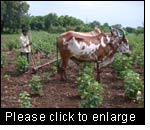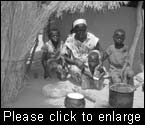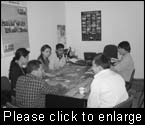InfoResources
News No 1 / 06 (March 2006)
Special feature
> Sustainable
products: An opportunity for small-scale farmers
Policy
> A glimmer
of hope for Ethiopian farmers
> Endangered ecosystem
services and human well-being in seven
African countries
> Decentralisation
of forest governance: Does it work?
> Connecting the
information society to sustainable development
> Forest law in Europe
and Northern Asia
Implementation
> Higher rice yields
with less input?
> Cash transfers
– a new idea for development cooperation
> Promoting
a gender-based approach and indigenous knowledge
> Experiencing the
dynamics of conflicts through play
Expert’s Opinion
> Managing
water demand in informal economies
Special Feature
Sustainable products: An opportunity for small-scale farmers
 Products
are referred to as “sustainable” if their production and marketing has
greater positive, or smaller negative, social, ecological and economic
impacts compared to conventional products. The market for sustainable
products is still rapidly growing. Many consumers prefer certified sustainable
products, considering them advantageous with regard to health, the environment,
and taste. In developing countries, the market for sustainable products
is still very small, but in economically emerging nations this could
soon change. Products
are referred to as “sustainable” if their production and marketing has
greater positive, or smaller negative, social, ecological and economic
impacts compared to conventional products. The market for sustainable
products is still rapidly growing. Many consumers prefer certified sustainable
products, considering them advantageous with regard to health, the environment,
and taste. In developing countries, the market for sustainable products
is still very small, but in economically emerging nations this could
soon change.
At a first glance, farmers in developing countries seem to have a head
start for producing sustainable products according to organic farming
standards: the ready availability of cheap labour fits in well with
the labour-intensive production methods. Moreover, traditional agriculture
as it is usually practised by small-scale farmers often hardly differs
from organic agriculture. Along with these comparative advantages, however,
there are also several disadvantages. Unlike in industrialised nations,
in developing countries there are generally no government subsidies
for organic farming. The fixed costs for organic product certification
are high. Farmers largely lack bothinformation on markets and access
to them, and domestic markets are as yet non-existent. In an effort
to improve this situation, a number of initiatives to promote sustainable
products have been launched at the national and international levels.
Organic farming is already practised in many developing countries. Two
studies by the International Fund for Agricultural Development (IFAD)
in Latin America and Asia have examined the potential of organic agriculture
for reducing poverty. Both studies have revealed that farmers who switched
to organic farming were always able to increase their income. Depending
on their initial situation, they could either reduce production costs
or increase yields. In addition, they benefited from higher prices for
organic products.
IFAD's studies have also shown that the adoption of organic farming
has positive effects on ecology, although to date only few research
projects have investigated this aspect: organic agriculture leads to
an increase in animal and plant species, can help to improve soil fertility,
and uses less water than conventional agriculture. Organic farming has
therefore led to considerable success particularly in areas with difficult
agroecological conditions.
These results show that organic agriculture does have a potential to
reduce poverty. It creates opportunities to increase income and reduce
risks by enhancing ecological stability. In addition, it contributes
to diversifying agricultural production. However, successful adoption
of organic production is not easy to carry through. Most importantly,
farmers need advice on organic cultivation technologies, but they also
need access to market information and marketing know-how. Finally, they
often depend on financial support during the phase of transition, which
usually takes about three years.
The evaluation of a Swiss-supported organic cotton programme in Mali,
Kyrgyzstan and Burkina Faso has reached similar conclusions. Like the
IFAD studies, it also puts particular emphasis on the importance of
strong producers' associations. This type of cooperation allows farmers
to professionally organise and coordinate the marketing of their products.
Moreover, it gives them the opportunity to exchange experiences and
secure quality control.
Organic agriculture is one of many adequate instruments to reduce poverty.
However, the price advantage will soon dwindle if too many farmers switch
to organic farming and the supply of organic products increases more
rapidly than the demand for them.
Sources:
> Challenging preconceptions about trade in sustainable products.
Towards win-win-win for developing countries. Nicola Borregaard and
Annie Dufey. International Institute for Environment and Development
(IIED), November 2005. www.iied.org/pubs/pdf/full/15500IIED.pdf
> Organic Agriculture and Poverty Reduction in Asia: China and
India Focus. International Fund for Agricultural Development (IFAD),
July 2005. 137 p.
The Adoption of Organic Agriculture Among Small Farmers in Latin America
and the Caribbean. IFAD, April 2003. 106 p. www.ifad.org/evaluation/public_html/eksyst/doc/thematic/organic/
index.htm
> Evaluation Externe du Programme Coton Biologique Mali,
Kirghizistan et Burkina Faso / 2005. Mandat du Secrétariat d'Etat
à l'économie (seco) présenté par Joseph
Guntern et Christof Dietler. Octobre 2005. 22 p.
www.helvetas.ch/global/pdf/media/medienmitteilungen/
2005_11_30_Evaluation_Helvetas.pdf
Further information:
> The Impact of Organic Cotton Farming on the Livelihoods
of Smallholders. Evidence from the Maikaal bioRe project in central
India. Frank Eyhorn, Paul Mäder, Mahesh Ramakrishnan. Research
Institute of Organic Agriculture (FiBL), October 2005. 75 p. Summary:
www.fibl.org/english/cooperation/projects/documents/
executive_summary.pdf
> Organic Cotton Production and Trade Promotion Project by Helvetas/seco
in Kyrgyzstan: www.swisscoop.kg/biocotton

Policy
A glimmer of hope for Ethiopian farmers
The Ethiopian highlands are marked by a vicious circle of food insecurity
and ecological degradation. More frequent droughts, land degradation
and population growth have led to a situation where more and more food
needs to be imported from outside. Researchers from the International
Food Policy Research Institute (IFPRI) have used a bioeconomic model
to identify development strategies for improving the situation both
of households and of the environment. The model takes into account a
multitude of biophysical and socioeconomic factors.
The model calculations have indicated that tree planting and a food-for-work
soil conservation programme are the most promising measures to improve
the situation: they can help to increase household income and at the
same time promote more sustainable land use. By contrast, measures such
as credits for buying fertiliser or the promotion of external sources
of income only make sense when combined with natural resource conservation
measures.
This model could yield interesting results for other regions as well,
provided that the data necessary for the analysis is available.
Source: Policy Analysis for Sustainable
Land Management and
Food Security in Ethiopia. A Bioeconomic Model with
Market Imperfections. Stein Holden, Bekele Shiferaw,
John Pender. Research Report 140. International Food
Policy Research Institute (IFPRI), 2005. 45 p.
www.ifpri.org/pubs/abstract/140/rr140.pdf
Endangered ecosystem services and human well-being in seven African
countries
Changes in ecosystem services have crucial impacts on poverty. The
linkages between ecosystem services and human well-being have been addressed
in the comprehensive Millennium Ecosystem Assessment (MEA) Synthesis
Report.
A literature study in Uganda has now applied the MEA framework. After
a short overview of Uganda's landscape and people, the report discusses
the most important ecological services currently under stress, followed
by the related threatened components of human wellbeing. In both sections,
the geographical locations concerned are indicated for each item. A
next section compares the regions where ecosystem services are under
stress with the regions where constituents of human well-being are threatened
and briefly outlines the main linkages. A declining capacity of the
ecosystems to adequately feed people, the loss of wetlands, dwindling
fuel sources, and a high risk of water supply crises are identified
as the key issues.
This report is part of a series of seven studies. Similar reports have
been published for Tanzania, Rwanda, Mozambique, Mauritania, Mali and
Kenya. Even if not exhaustive, these studies do offer useful guidance
in how to select priority areas.
Source:Connecting poverty & ecosystem
services: Focus on Uganda. A series of seven country scoping studies.
Carissa Wong, Marlene Roy, Dr. Anantha Kumar Duraiappah. UNEP, IISD
2005. 36 p.
www.iisd.org/pdf/2005/economics_poverty_uganda.pdf
All country scoping studies are available at IISD's website:
www.iisd.org/economics
Decentralisation of forest governance: Does it work?
 Over
the last two decades, many countries have made efforts to decentralise
the governance of their forests. This process was expected to bring
about increased participation, accountability and democratisation in
forest governance. Over
the last two decades, many countries have made efforts to decentralise
the governance of their forests. This process was expected to bring
about increased participation, accountability and democratisation in
forest governance.
In reality, however, decentralisation is not a panacea, nor does it
necessarily lead to equity and efficiency. On the contrary, it has often
entailed conflicts when existing tensions among competing individuals
or groups of stakeholders were intensified due to legal and administrative
uncertainties.
Nevertheless, under certain conditions decentralisation can yield positive
results and contribute to poverty alleviation and sustainable forest
management. Successful efforts share several important features: secure
land tenure; secure fiscal, revenue and taxation powers; equitable access
to forest resources; control over decision-making; commercial rights
and market access; and sensitivity to cultural traditions and local
knowledge.
Enabling legal and policy frameworks, along with basic institutional
capacities, are a precondition for successful decentralisation. Further
requirements include the capacity to conduct negotiations among different,
unequally powerful stakeholders with competing interests, as well as
conflict-solving capacities. Decentralisation processes are time-demanding
and should be implemented gradually, giving stakeholders and institutions
the opportunity to adapt and to learn. Decentralisation works best when
driven by reinforcing pressures both from the bottom and from the top.
Source: Decentralization: Issues, Lessons
and Reflections. Doris Capistrano and Carol J. Pierce Colfer. In: The
Politics of Decentralization – Forests Power and People. pp. 297–313.
The Earthscan Forestry Library, 2005.

Connecting the information society to sustainable development
In 2003, a study aimed to assess the potential of engaging young researchers
in six countries to link up political decision- makers, practitioners
and academics working in the fields of information society and sustainable
development. The publication “A developing connection” follows on from
this study. It is based on case studies where this procedure has been
put into practice.
In India, researchers brought together leaders of local grass-roots
organisations to examine their information technology and communication
(ITC) needs. For example, with regard to water management, the leaders
suggested introducing an awareness campaign among school children. They
also voiced a need for the systematic documentation of the environmental
dimensions of managing this natural resource, as well as access to such
information.
Furthermore, these leaders felt that other areas such as deforestation,
natural disasters and the use of fertilisers show untapped potential
for ITC applications.
Nevertheless, given the stratification of Indian society, such as its
caste system, it is not so straightforward for decision-makers to take
account of proposals originating from the “grass roots” and passed on
by esearchers.
Source: Capturing grassroots voices in
the information society and sustainable development. Anusha Lall, Atanu
Garai. In: A developing connection: Bridging the policy gap between
the information society and sustainable development. Ed. Terri Willard,
Maja Andjelkovic. IISD, 2005. pp.129–160.
www.iisd.org/pdf/2005/networks_dev_connection.pdf
Forest law in Europe and Northern Asia
At the end of November 2005, St. Petersburg hosted the “Europe and
North Asia Forest Law Enforcement and Governance Ministerial Conference
(ENA FLEG)”. On the agenda were the development of the Ministerial Declaration
and the definition of efforts needed to ensure both the enforcement
of legislation and good governance to combat the illegal exploitation
of forest resources in Europe and North Asia.
In a parallel session, intergovernmental negotiations were held with
the Civil Society and Industry Dialogue (CSID) to develop a joint position
on the Ministerial Declaration and the Indicative Action Plan.
The Ministerial Declaration was adopted by representatives of 43 national
governments and the European Commission. At the national level, efforts
focus primarily on the revision of legislation, institutional development
and capacity building, as well as poverty alleviation. At the international
level, action is to be taken on international forestry policy, business
and trade, research as well as cooperation to ensure the implementation
of the Ministerial Declaration.
Sources:
> ENA FLEG website
http://web.worldbank.org/WBSITE/EXTERNAL/TOPICS/
EXTARD/EXTFORESTS/0,,contentMDK:20636566~pagePK:
210058~piPK:210062~theSitePK:985785,00.html
> Europe and North Asia Forest Law Enforcement and Governance Ministerial
Conference (ENA FLEG). Summary:
www.iisd.ca/download/pdf/sd/ymbvol110num5e.pdf
> St. Petersburg Declaration:
www.delkaz.cec.eu.int/upload/download_files/
StPetersburgDeclarationEN.pdf

Implementation
Higher rice yields with less input?
A press release issued by the Institute of Science in Society (ISIS)
reports that farmers in southern Nepal have tested a low-input rice
cultivation method called “System of Rice Intensification (SRI)” during
the past three years. Using only a fraction of the normal amount of
seedlings and far less water than usual, their yield has more than doubled.
The main innovation was to remove the seedlings from the nursery beds
after 2 instead of 6 weeks, transferring them to drained instead of
flooded fields. Moreover, the spacing between the seedlings was increased,
leading to better root development.
While – according to ISIS – more and more farmers are convinced of the
new method, scientists remain reluctant. Research institutions such
as the International Rice Research Institute (IRRI) continue to promote
high-input agriculture and biotechnology. Doubts are being voiced on
whether IRRI and the Consultative Group on International Agricultural
Research (CGIAR) actually direct their research and its implementation
primarily towards improving the standard of living of low-income rice
farmers and consumers. ISIS demands that these institutions join in
efforts to free farmers of their dependence on agrochemical technologies,
promote sustainable agriculture, conserve the environment, and protect
the farmers’ health.
The results from Nepal are not uncontested. Based on its own tests,
IRRI has doubted the effectiveness of the System of Rice Intensification.
Source: Less is More for Nepali Rice.
Press Release of Institute of
Science in Society (ISIS). 06.10.2005. www.i-sis.org.uk/LIMFNR.php
More information on SRI: http://ciifad.cornell.edu/sri/sripapers.html
Cash transfers – a new idea for development cooperation
 The
topic of “Cash transfers” was investigated in one of the projects presented
in October 2005 in Berne at a symposium entitled “Poor health, food
insecurity and poverty – How to break a vicious circle?” According to
the author, cash transfers are the best-adapted and most effective means
of supporting extremely poor households. This judgement is based on
the assumption that the beneficiaries themselves know best how to make
most appropriate use of the money they are paid. The
topic of “Cash transfers” was investigated in one of the projects presented
in October 2005 in Berne at a symposium entitled “Poor health, food
insecurity and poverty – How to break a vicious circle?” According to
the author, cash transfers are the best-adapted and most effective means
of supporting extremely poor households. This judgement is based on
the assumption that the beneficiaries themselves know best how to make
most appropriate use of the money they are paid.
The hypothesis has been tested in southern Zambia in 1000 poor households
with limited options for self-help. Each of the households was paid
6 to 8 dollars per month. After a 5-month testing phase, results indicated
that around 95% of the beneficiaries actually did belong to the intended
target group. The money was spent mainly on maize, but partly also on
sanitary products and clothes. Surprisingly, several households were
able to accumulate small savings. Some of them invested hismoney in
hens, and some households headed by elderly farmers hired workers to
help with the fieldwork.
In the course of the project, begging decreased, children attended school
more regularly, and their nutritional status improved.
However, widespread implementation of this approach is hindered by several
necessary preconditions, such as the establishment of an extensive network
of cash distribution points. Cash transfers therefore remain only one
of many possible strategies for public welfare.
Source: Pilot Social Cash Transfer
Scheme – Kalomo District, Zambia.
Bernd Schubert. Humboldt University, Germany. Presentation at the Symposium
“Poor health, food insecurity and poverty – How to break a vicious circle?”
(Berne, Switzerland, 13 October 2005). Slides (17 p.) www.infoagrar.ch/symposium2005/pdf/presentation_schubert.pdf

Promoting a gender-based approach and indigenous knowledge
In many places throughout the world, indigenous people, and in particular
women, are key players in maintaining the balance of natural ecosystems.
However, when it comes to natural resource management projects, there
are numerous obstacles, which prevent the inclusion of gender aspects
and indigenous knowledge.
The “Indigenous and gender aspects in natural resource management (IGNARM)”
network issued a guide, based on a catalogue of experiences in which
there is interplay between these three thematic issues. For development
practitioners, the guidelines tackle all the key questions, which may
arise at each stage of a project cycle: from identification to monitoring/evaluation.
During any examination of existing legislation, any contact with communities
and local institutions, or the identification of the project's target
population, it is essential that the opinions of men and women, both
indigenous and non-indigenous, are given due consideration. It is also
imperative that women contribute to the design of a project, particularly
given that men, for cultural reasons, often find it difficult to accept
their involvement.
Finally, the identification of the cultural links, which the indigenous
male and female populations have with their natural environment and
resources, and their respective tasks, will help to provide a better
definition of the objectives and activities of the given project.
Source: Integrating
indigenous and gender aspects in natural resource management: guidelines
for practitioners. Elisabeth Kiorboe… [et al.]. WWF, 2005. 48 p. www.iucn.org/themes/spg/Files/DK%20IGNARM.pdf
Experiencing the dynamics of conflicts through play
 Three
families living around a lake earn their livelihood either from rice
cultivation, vegetable farming or livestock breeding. All three families
depend on the use of lake water. This is the point of departure for
a simulation game entitled “Conflict Mitigation in Communities” (CONMICOM),
developed at the Centre for Development and Environment under
a mandate financed by the Swiss Agency for Development and Cooperation
(SDC). In the course of the game, population growth and growing needs
lead to an increased demand for water, threatening the sustainability
of water use. Conflicts emerge. Will the families cooperate or compete
with one another? Three
families living around a lake earn their livelihood either from rice
cultivation, vegetable farming or livestock breeding. All three families
depend on the use of lake water. This is the point of departure for
a simulation game entitled “Conflict Mitigation in Communities” (CONMICOM),
developed at the Centre for Development and Environment under
a mandate financed by the Swiss Agency for Development and Cooperation
(SDC). In the course of the game, population growth and growing needs
lead to an increased demand for water, threatening the sustainability
of water use. Conflicts emerge. Will the families cooperate or compete
with one another?
Three groups of 3 to 5 players each have a set of options for action
that follow four different strategies:
- power play
- negotiation and cooperation
- developing efficient water management and alternative income opportunities
- waiting to see what happens
During the game, players can perceive the development of conflicts,
discuss negotiating and problem-solving mechanisms, and mirror them
in their own real experiences. A debriefing session with the participants
after the game forms a substantial part of the learning process that
can reinforce social competence, as well as problem-solving and decision-making
capacities. The game is well-suited for use as a module within training
courses, for example for project workers.
Information: Readers who are
interested in using the game are asked to contact Markus Reisle of SDC's
Division for Conflict Prevention and Transformation: markus.reisle@deza.admin.ch
More information on simulation and learning games:
www.cde.unibe.ch/Tools/ALS_ProdServ_Ts.asp#sg
Contact person:
Felicitas Bachmann, Centre for Development and Environment, (CDE), Felicitas.Bachmann@cde.unibe.ch

Expert’s
Opinion
Managing water demand in informal economies
 In
the past years, the focus of interventions in the water sector has shifted
from demand-driven water supply to more efficient water use. This is
particularly true of rural areas. In a presentation at the Swiss Agency
for Development and Cooperation (SDC) and a subsequent interview with
InfoResources, Tushaar Shah emphasises that the greatest challenge faced
by the water sector in developing countries is the fact that it is largely
organised within the informal economy. He criticises that important
instruments of Integrated Water Resources Management (IWRM), such as
water prices, permits and regulations, are based on the assumption that
the water sector is part of the formal economy. In
the past years, the focus of interventions in the water sector has shifted
from demand-driven water supply to more efficient water use. This is
particularly true of rural areas. In a presentation at the Swiss Agency
for Development and Cooperation (SDC) and a subsequent interview with
InfoResources, Tushaar Shah emphasises that the greatest challenge faced
by the water sector in developing countries is the fact that it is largely
organised within the informal economy. He criticises that important
instruments of Integrated Water Resources Management (IWRM), such as
water prices, permits and regulations, are based on the assumption that
the water sector is part of the formal economy.
Tushaar Shah lists the following elements that he considers crucial
to sustainable water management in informal economies:
- Water policies that were adequate in the past must be adapted to
current conditions. This requires a thorough and extensive understanding
of national water economy.
- Water resource management must not be limited by sectoral thinking;
it should include overall development dynamics.
- Development of infrastructure and services in the water sector
remains an important task of the governments of less developed countries.
- People who are directly concerned must consistently be involved
in the planning of interventions.
- “Technifications” such as drip irrigation contribute to making
water use more efficient.
- Cropping patterns must be better adapted to climatic conditions,
and innovative cultivation methods should be encouraged.
Creating non-agricultural income opportunities, particularly
for the poor, remains an indispensable measure to reduce pressure on
agriculture and, consequently, on water resources.
Source: Full
interview and presentation  10p., 59 KB 10p., 59 KB
See also SDC's new Water strategy: Water 2015: Policy Principles and
Strategic Guidelines for Integrated Water Resource Management. Swiss
Agency for Development and Cooperation. 2005. 40 p.
http://162.23.39.120/dezaweb/ressources/resource_en_25138.pdf

|





